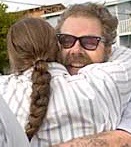 Glen Nickerson About an hour after midnight on September 15, 1984, Santa Clara County sheriff’s deputies responded to a call of gunshots at a house on Ronda Street in San Jose, California. The officers found John Evans lying in the front entryway with a gunshot wound to the head.
Inside the house, officers found Michael Osorio in the hallway and the body of Mickie Lee King in the kitchen. Both men were shot in the back of the head and their hands were handcuffed behind their back.
Only Osorio survived.
The prosecution of the case would become the longest and most expensive murder case in Santa Clara County history.
The home where the shooting occurred was in an unincorporated area of San Jose and was owned by John Evans at the time of the murders. Evans was King’s half-brother and a reputed methamphetamine dealer.
A police dog, “Ajax,” was brought to the scene and when officers discovered a fingertip of a bloodstained glove under a car in Evans’s driveway, the dog picked up a scent and ultimately led officers to a pond in an apartment complex. Along the way, officers discovered a rubber glove and a cloth glove, blood spatters on a driveway and the wall of a garage, a bloody handprint on a dumpster, and a number of .357-caliber shell casings.
Police focused on Glen “Buddy” Nickerson because less than a month earlier, Nickerson’s brother, Nicky Nickerson went to Evans’s house with a shotgun, grabbed Evans’s live-in girlfriend as a hostage and demanded that Evans come out and talk to him. Evans did and wounded Nicky Nickerson in the chest.
Two witnesses—Osorio and Brian Tripp, a resident of a nearby apartment complex, identified Glen Nickerson. Osorio said Nickerson was the gunman, although his identification came a day later, after he had brain surgery for his gunshot wound. Although he said his confidence level was 10 out of 10, in fact it was based on someone using the word “buddy” during the shooting and that one of the gunmen was heavyset—as was Nickerson.
Tripp said he saw a man he identified as Nickerson fleeing the shooting. Yet another witness, Sharon Silberhorn identified Nickerson as a man she saw in a car near Evans’s house the night before the shooting.
On April 1, 1985, Nickerson was charged with two counts of murder and one count of attempted murder. Also charged were Bret Wofford, Murray Lodge, Jr., and Dennis Hamilton.
Wofford pled guilty to accessory to murder and Lodge’s case was severed. Nickerson and Hamilton went on trial on December 8, 1986.
On April 16, 1987, Nickerson and Hamilton were convicted. Both were sentenced to life in prison without parole.
Nickerson lost his direct appeal and on November 30, 1989, the California Supreme Court denied review of the appellate court’s decision.
Lodge went to trial in 1992 and at some point, the lawyers for Lodge became aware of new evidence that suggested Nickerson was innocent. The case ended in a mistrial. In 1994, Lodge was convicted, but only after yet another mistrial. He also was sentenced to life in prison without parole.
The lawyers for Lodge, Gerald Schwartzbach and Edward Sousa, became convinced that two of the detectives in the case had suppressed exculpatory evidence, committed perjury and tainted critical witnesses against Nickerson.
They discovered that the detectives had suppressed a tape recording that revealed that Lodge had made incriminating statements without receiving his Miranda warning. They also found that the detectives had improperly influenced the testimony of eyewitness Brian Tripp, who had positively identified Nickerson at his trial.
Significantly, they figured out that the testimony of Osorio was not credible and they discovered that another prosecution witness, Sharon Silberhorn, had failed to identify Nickerson in a photo line-up during the initial investigation.
Sousa and Schwartzbach decided to take up Nickerson’s case and in June 1996, Lodge waived his right to object to any conflict of interest and told them that Nickerson was innocent.
Almost a year later, on April 23, 1997, they filed a petition for writ of habeas corpus in Santa Clara County Superior Court. It was denied on April 14, 1998.
In 2001, another man was convicted in the case. William Jahn was linked by DNA testing to the blood found on the sidewalk. He was sentenced to life in prison. His conviction helped Nickerson because the evidence showed that he—not Nickerson—was the person that witnesses saw leaving the scene of the shooting.
On March 17, 2003, Marilyn Hall Patel, Chief U.S. District Judge for the Northern District of California, vacated Nickerson’s conviction and ordered a new trial.
The judge found rampant police misconduct in coercing the identifications of Nickerson and the failure to turn exculpatory evidence over to the defense.
On March 21, 2003, Nickerson was freed on bail, but kept under electronic surveillance. On May 19, 2003, he was released and the charges were dismissed.
Nickerson reached a settlement with Santa Clara County for $500,000 plus 120 monthly payments of $3,700(a total of $444,000).
– Maurice Possley |